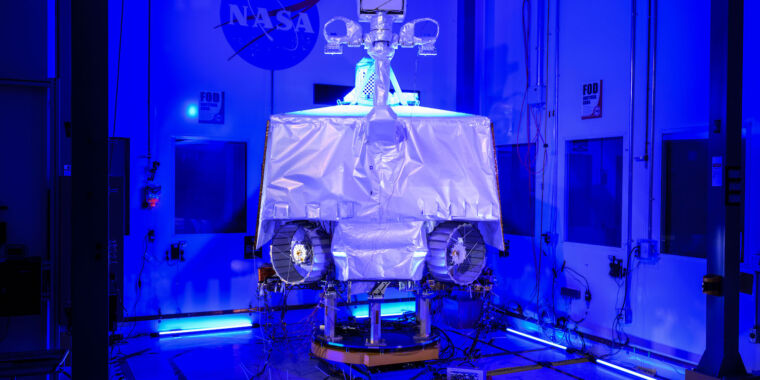NASA spent $450 million to design and build the first robot to enter the forever-dark crater on the moon’s south pole, but the agency announced Wednesday it was canceling the rover because of delays and cost overruns.
“NASA will be canceling the VIPER mission,” said NASA’s Science Mission Director Nicky Fox. “Decisions like these are never easy, and we certainly did not make this decision lightly. In this case, the remaining projected costs of VIPER would force us to cancel or halt many other missions in the Commercial Lunar Payload Services (CLPS) line.”
NASA has canceled science missions before because of development delays and cost overruns, but it rarely cancels missions with spacecraft already built.
The Volatile Investigation Polar Rover (VIPER) mission was supposed to be a robotic reconnaissance vehicle for NASA’s Artemis program, which aims to return astronauts to the lunar surface within a few years. VIPER was originally scheduled to launch in late 2023 and fly to the Moon aboard a commercial lander provided by Pittsburgh-based Astrobotic. The company was awarded a contract by NASA in 2020 to deliver the VIPER rover to the lunar surface. Astrobotic is one of 14 contractors for NASA’s CLPS program, which aims to deliver government-sponsored science payloads to the Moon.
But VIPER has been delayed by at least two years (its latest plan was for it to launch in September 2025), and costs have ballooned from $433 million to more than $609 million. The ballooning costs automatically triggered NASA to begin considering whether to continue or cancel the mission. Ultimately, officials said NASA decided it could not afford the additional costs of VIPER without impacting other lunar missions.
“So we’ve made the decision to abandon this particular mission, the VIPER mission, in order to preserve the overall program,” Fox said.
“It’s unfortunate,” said Astrobotic CEO John Thornton, “and it’s tough news for sure. VIPER has been a great team to work with, and it’s a shame we won’t get the opportunity to fly them to the Moon.”
NASA said it will consider “expressions of interest” from U.S. industry and international partners who want to use the existing VIPER rover at no cost to the government by Aug. 1. If NASA can’t find someone willing to take VIPER and pay to transport it to the moon, it plans to dismantle the rover and salvage its instruments and parts for future lunar missions.
Scientists were disappointed with VIPER’s cancellation.
“Frankly, this is ridiculous,” said Clive Neal, a planetary geologist at the University of Notre Dame. “It just doesn’t make economic sense. You’re cancelling a mission that’s completed, built, and ready to go, and we’re still in the middle of testing.”
“This is a big mistake,” writes planetary physicist Phil Metzger of the University of Central Florida. In X’s post“This was the first mission to measure the lateral and vertical variations of ice in lunar soil. It would have been revolutionary. No other mission can make up for what has been lost here.”
Built with no place to go
Engineers at NASA’s Johnson Space Center in Houston finished assembling the VIPER rover last month, and managers have authorized environmental testing of the rover to ensure it can withstand the sounds and vibrations of launch and the extreme temperatures it will encounter in space.
Instead, NASA canceled the mission after spending $450 million to get it this far. “This is a very tough decision, but it’s a decision based on budgetary concerns in a very tough budget environment,” Fox told reporters Wednesday.
About the size of a golf cart, with four wheels, a headlight, a drill and three scientific instruments, VIPER will search for water ice in a depression near the moon’s south pole that has been blocked from sunlight for billions of years. This turns areas of so-called permanent shadow into cold traps, allowing water ice to accumulate on or near the surface. Future astronauts could use it as a source of drinking water and oxygen, or convert it into electricity or rocket fuel.
But first scientists need to know exactly where the water is and how easy it is to get there. VIPER was meant to be the next step in mapping resources on the moon’s surface, providing ground-based measurements to corroborate remote-sensing data from satellites in lunar orbit.
However, delayed component deliveries delayed construction of the VIPER rover, and in 2022 NASA ordered additional testing of Astrobotic’s Griffin lunar lander to improve VIPER’s chances of a successful landing. This pushed VIPER’s launch back from late 2023 to late 2024, and earlier this year further supply chain issues for the VIPER rover and Griffin lander caused the launch to be pushed back until September 2025.
This latest delay has increased VIPER’s projected cost by more than 30% over the original mission cost, prompting NASA to consider aborting the mission. Although the rover is now fully assembled, NASA still needed to put the rover through a lengthy battery of tests, complete development of the ground systems that will control VIPER on the lunar surface, and hand the rover over to Astrobotic for integration into the Griffin lander.
The remaining work to complete VIPER and operate it on the lunar surface for 100 days will cost about $84 million, Kearns said.


